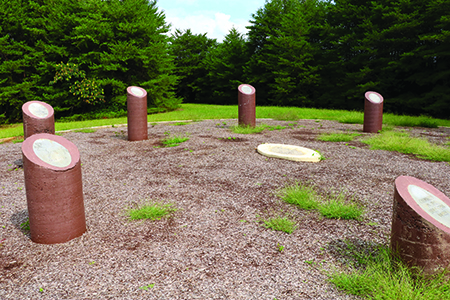By SCOTT MCKIE B.P.
One Feather Staff
Once again, a bill that would place 76 acres of land containing several historic sites in eastern Tennessee in trust for the Eastern Band of Cherokee Indians (EBCI) has passed the U.S. House of Representatives. The Eastern Band of Cherokee Historic Lands Reacquisition Act, H.R. 2088, passed by a margin of 407-16.
“For the third Congress in a row, the House in a wide bipartisan vote, passed my bill to return 76 acres of sacred land in Monroe County to the Eastern Band of Cherokee Indians; righting a terrible wrong when their land was forcibly taken from them by the federal government,” Rep. Chuck Fleischmann (R–Tenn.) said in a statement.

A bill that would place 76 acres of land containing several historic sites, such as the Chota Memorial, in eastern Tennessee in trust for the Eastern Band of Cherokee Indians (EBCI) has passed the U.S. House of Representatives. The Eastern Band of Cherokee Historic Lands Reacquisition Act, H.R. 2088, passed by a margin of 407-16. (SCOTT MCKIE B.P./One Feather photo)
Rep. Fleischmann, who introduced the bill in March, added, “The Cherokee People have a long, rich history on these lands, and it is the place where Cherokees have honored the birth and life of Sequoyah, one of the most influential and important Native Americans in history. I am humbled and thankful to play a part in ensuring the story of the Eastern Band is preserved and taught to future generations.”
Principal Chief Richard G. Sneed, who testified on a past bill in 2017, said in a statement, “Sequoyah was a seminal leader who contributed so much to help the Cherokee people. And while this bill faces a long legislative path ahead, I could not be prouder of the efforts to preserve and protect this important memorial for generations to come. I would personally like to thank members of the Tennessee delegation, particularly, Rep. Charles Fleischmann (R-Tenn.) who championed the effort to protect Cherokee history in the region. We are grateful for his continued leadership on this effort.”
According to language in the bill, the 76 acres includes approximately 46 acres at the site of the Sequoyah Birthplace Museum, around 18.2 acres which includes the Chota Memorial and the Tanasi Memorial, and another 11.2 acres known as “support parcel”. Also included in the bill are permanent easements for the Chota Peninsula, which includes 8.5 acres and the Chota-Tanasi Trail which has 11.4 acres.
The Chota Memorial includes a full-scale representation of the Council House and sits in the spot of the original structure at Chota. The Tanasi Memorial, built by the TVA and the Tennessee Historical Commission in 1989, contains a monument with an inscription that states in part, “The site of the former town of Tanasi, now underwater, is located about 300 yards west of this marker.”
Charlie Rhodharmer, Sequoyah Birthplace Museum director, noted the importance of the area, “Tanasi was the first Cherokee capital in what is now this area of east Tennessee. It was set up by Moytoy of Tellico in the late 1720s/1730s. Moytoy was the first ‘emperor’ (spokesman) of the Cherokee. By 1753, Chota had become the mother town of the Overhill. During the 18th century, Chota was the political and cultural capital of the Cherokee Nation. It was known as a peace town.”
He added, “Chota was the longest existing Cherokee capital in the east before the Removal. Chota is center stage for Lt. Henry Timberlake’s visit. Timberlake wrote his memoirs of his visit to the Cherokee Overhill, which gives us an incredible insight into Cherokee life and culture in the mid-18th century. By 1788, the Cherokee had moved their capital south to Georgia.”
Gaming, both Class II and Class III, would be prohibited on these lands.
The Tennessee Valley Authority would still maintain some authority over the lands. The bill states, “The Tennessee Valley Authority may temporarily and intermittently flood the lands subject to this Act that lie below the 824-foot (MSL) contour elevation and the road access to such lands that lie below the 824-foot (MSL) contour elevation.”
Subsections (f) and (g) in Section 5 outline more on the Tennessee Valley Authority. “(f) Right Of Entry.—The lands subject to this Act shall be subject to a reasonable right of entry by the personnel of the Tennessee Valley Authority and agents of the Tennessee Valley Authority operating in their official capacities as necessary for purposes of carrying out the Tennessee Valley Authority’s statutory program for river control and development. (g) Entry Onto Land.—To the extent that the Tennessee Valley Authority’s operations on the lands subject to this Act do not unreasonably interfere with the Eastern Band of Cherokee Indians’ maintenance of an appropriate setting for the memorialization of Cherokee history or culture on the lands and its operations on the lands, the Eastern Band of Cherokee Indians shall allow the Tennessee Valley Authority to enter the lands to clear, ditch, dredge, and drain said lands and apply larvicides and chemicals thereon or to conduct bank protection work and erect structures necessary in the promotion and furtherance of public health, flood control, and navigation.”
The bill has now been received in the Senate, read twice, and has been referred to the Senate Committee on Indian Affairs.
Previous versions of the bill included H.R. 453 (116th Congress) which passed by a unanimous voice vote and H.R. 146 (115th Congress) which passed the House 383-2.





